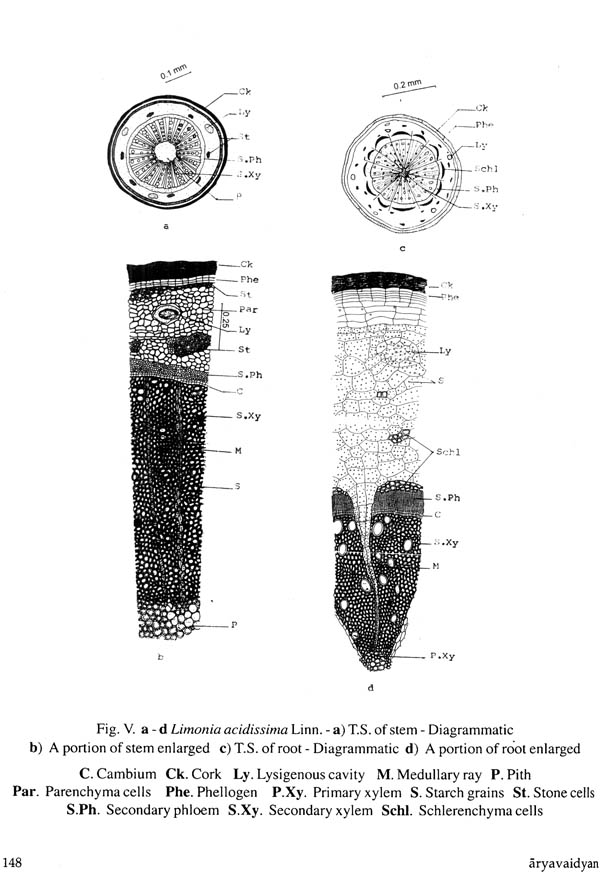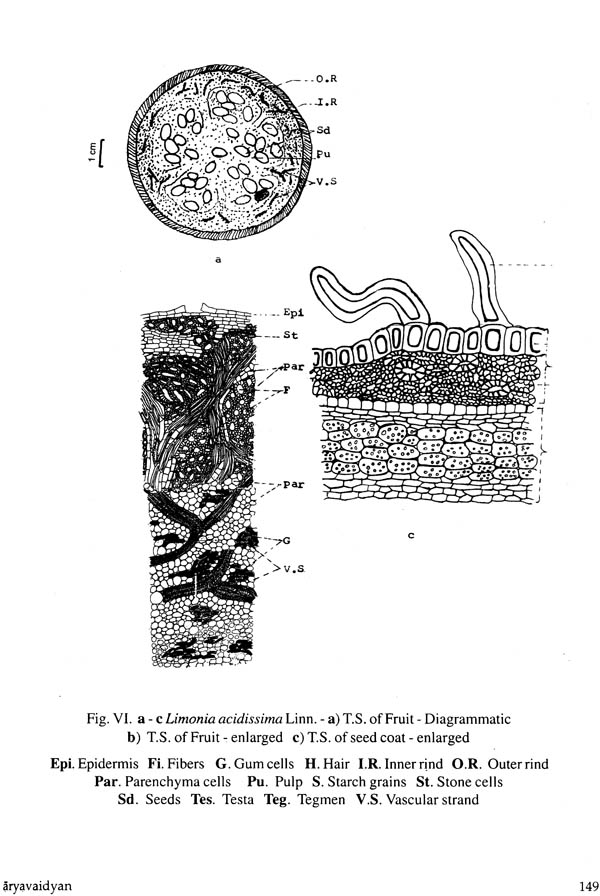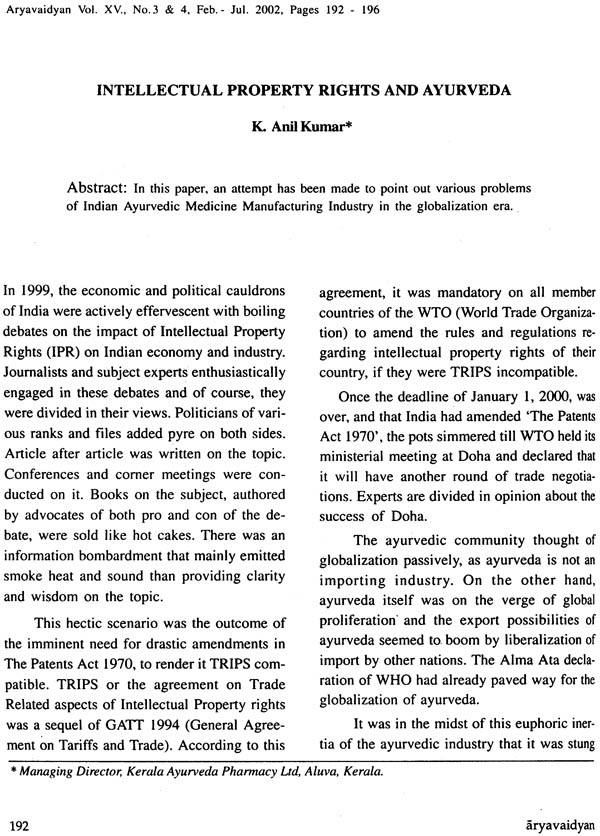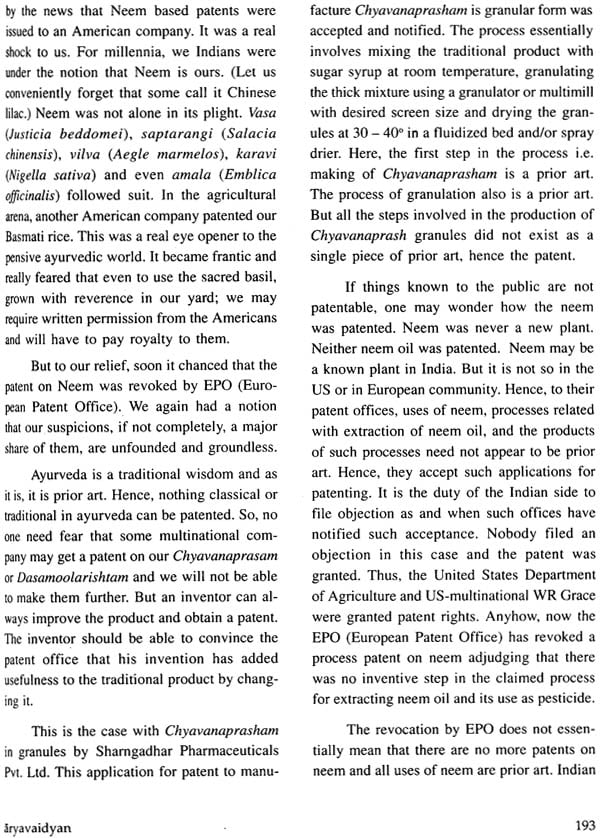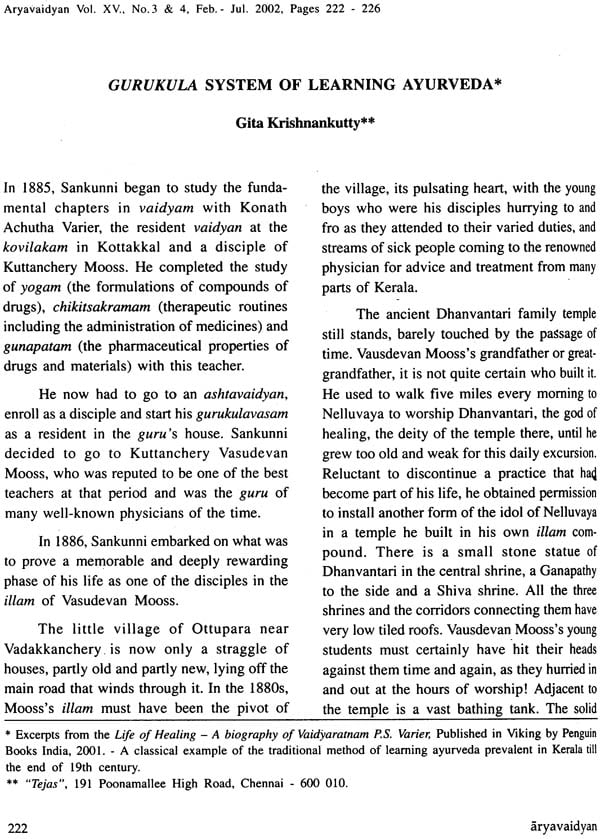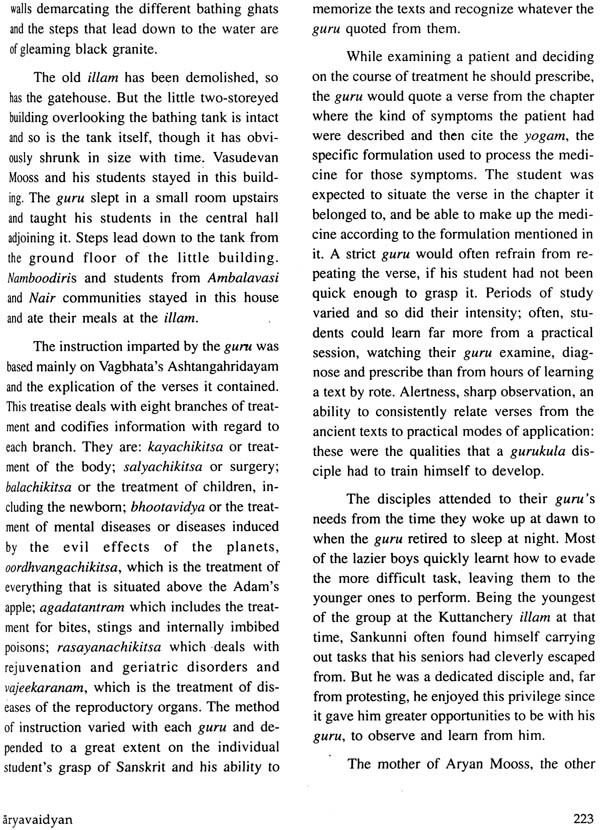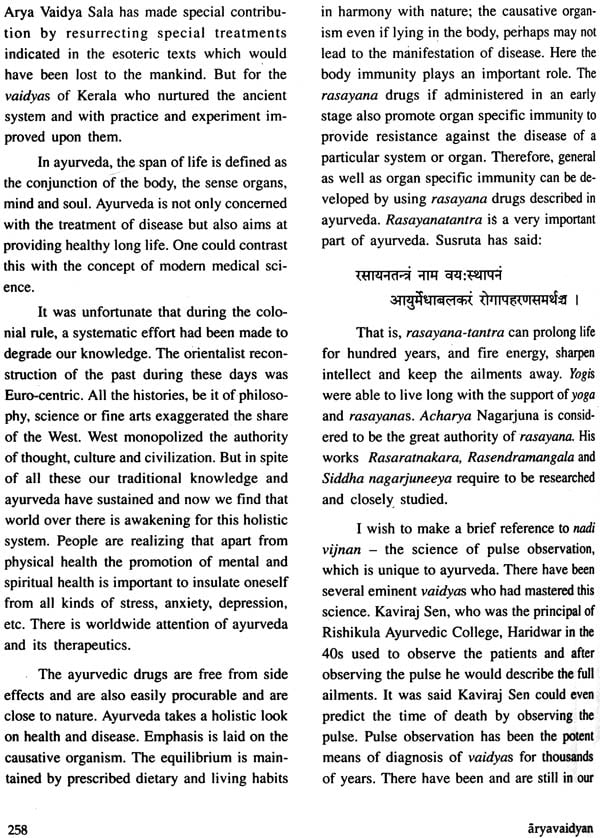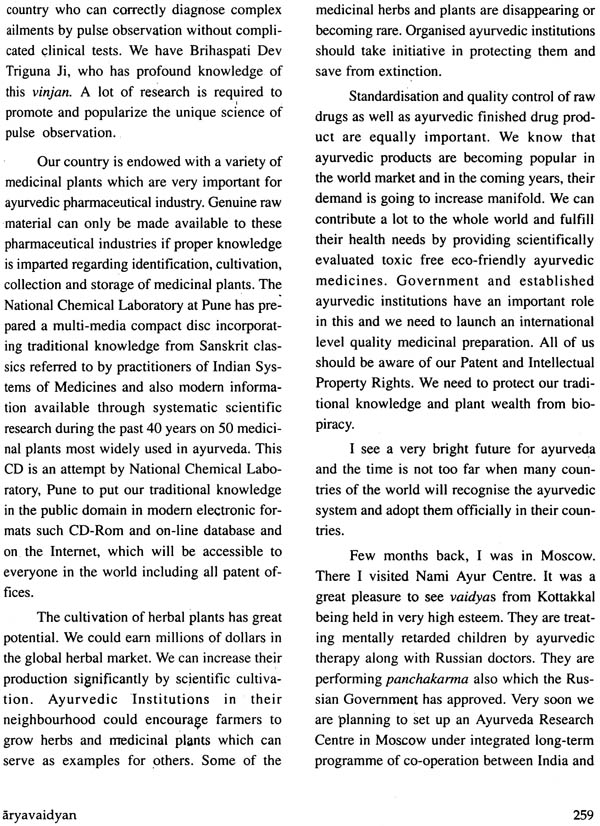
Aryavaidyan (A Quarterly Journal of The Arya Vaidya Sala - Kottakkal)
Book Specification
| Item Code: | IDC148 |
| Author: | Dr. K.G. Paulose, Hon. Consulting Editors Dr. N.V.K. Varier and Dr. K. Madhavankutty |
| Publisher: | Centenary Special |
| Language: | English |
| Edition: | 2002 |
| Pages: | 134 (Illustrated Throughout In B/W Figures) |
| Cover: | Paperback |
| Other Details | 9.5" X 7.2" |
| Weight | 380 gm |
Book Description
Editorial
The hundred years that passed by were eventful in the annals of the history of ayurveda. Never before did the system face such a strong challenge. In its three-millennium record, it had, for the first time, an encounter with an alien culture. The new wave had two things to its advantage - a post-industrial revolutionary zeal and the patronage of the ruling class. Ayurveda came to the verge of extinction; it had to struggle hard for existence. It is a different story that by the end of the century it came out victorious and won world-wide recognition which it never had dreamt at no phase in its history. The point here is that it had to undergo the litmus-text for survival.
The struggle itself was historic. In the first phase it had virtually lost the battle. Later ayurveda won the fight because, by the time, it was not alone in the field. The new national awakening, search for our own identity, renaissance notions of universal brother-hood, breakdown of the rigid societal structure-all these contributed to the resurrection of the ancient knowledge systems. All over the country, there were stalwarts to walk ahead bearing the torch of enlightenment - Sankar Sastri Pade in Maharashtra, Gananath Sen in Bengal, to name only two from the field of anyurveda. This mantle in the south fell on P.S. Varier. His role in rejuvenating the ailing system is well recognized. All are unanimous to state that the Arya Vaidya Sala, founded by Vaidyaratnam P.S. Varier symbolizes the cultural renaissance of traditional knowledge, No wonder, the century of Arya Vaidya Sala became a national even for all.
During the years passed, there were changes in all the branches of Ayurvedic activities - manufacturing of medicines, quality control, standardization, etc. but the most revolutionary events occurred in the field of education. The process of socialization of knowledge was the landmark of the era. The hundred years transformed the mind-set cultivated through thousand years. The single factor responsible for this transformation is education. Mass-based institutional studies replaced the age-old preceptor-disciple-based traditional system; curricula underwent drastic re-shuffle and teachers invented new methods for teaching. In short, the personalized experiences transmitted though generations were subjected to scientific evaluation. The process, in general, elevated the status of ayurveda in the eyes of the masses. This issue of the journal gives a glimpse of the evolutionary process and tries to evaluate the merits of the emerging situation. Our contributors represent different constituencies - educationists, teachers, research scholars and students. The discussants also have in their mind the recommendations of the draft national policy on Indian Systems of Medicines, 2001. We look forward for our Readers’ response on this sensitive subject.
The third part of this combined volume carries a brief report of the inauguration of the centenary celebrations and 56th plenary session of All India Ayurvedic Congress. The Scientific Seminar spread over seven technical sessions delighted the academic community very much. Thirty-six research papers were presented for discussion. The proceeds of the Seminar will be published separately.
We were serializing the English commentary of Rasavaiseshikasootra of Bhadanta Nagarjuna for the last twenty-seven issues beginning from Vol. VII, No. 3- 1994. It is complete by this issues. The text in four chapters covered various aspects of pharmacology. The commentary by the eminent physician Vaidyabhooshanam K. Raghavan Thirumulpad will be highly useful to those interested in dravyagunavijnana. The scholarly world is, undoubtedly, indebted to the erudite commentator.
We would like to add few columns in the journal to felicitate more meaningful inter-action with our readers. Proposals are invited. The Research Corner is devoted exclusively for the research activities in universities, colleges and other institutions. Send in your details.
| Editorial | ||
| PART - REGULAR FEATURES | ||
| From the pages of Vagbhata - LVIII | N.V.K. Varier | 135 |
| Abstract: In this chapter, an elaborate description regarding aschotana is mentioned. Regarding the procedure of anjana, its types, time of application and contra-indications are also mentioned | ||
| Pharmacognostical studies on vilavu (Limonia acidissima Linn.) | V.P. Krishnan Nambiar, A. Jayanthi and T.K. Sabu | 141 |
| Abstract: Pharmacognostic studies, chemical analysis, propagation & cultivation techniques are included in this paper. Numerical data like palisade ratio, stomatal index and vein-islet number are also dealt with | ||
| Effect of Kerala systems of snehana and svedana kriyas in degenerative diseases | P.M. Varier and N. Manojkumar | 157 |
| Abstract: Degenerative diseases are understood by classical Ayurvedic approach as a group of ailments resulting from dhatusaithilya and dhatukshaya (systemic decay). And they extensively affect vital organs and systems. These diseases are mostly progressive in nature and their etiology is comparatively less understood. The Ayurvedic approach to combat degeneration involved steps to achieve dhatusthiratva and dhatuvarddhana by the way of snehana and svedana. The paper will consider the various aspects of the principles and practices of these modalities. | ||
| On the need for setting standards for raw-drugs used in Ayurvedic industry | C. Ramankutty | 163 |
| Abstract: The Ayurvedic drug industry is poised for a quantum jump in terms of its popularity and acceptability. This positive trend is accompanied by a series of negative consequences. Curtailed availability of raw material of the right quality in the right quantity is the most important negative consequence. At the present rate of growth, the industry may find itself denied of the required material support in the near future. Several are the discrepancies and controversies existing in the field of identification and authentication of raw herbs. This paper attempts to consider some of the salient aspects. | ||
| Histopathological evaluation of high anal fistula with ksharasootra | M. Bhaskar Rao | 169 |
| Abstract: The ksharasootra application is a well-established procedure in the management of fistula-in-ano with a high success rate. Here, an attempt has been made to establish the ksharasootra’s efficacy in high and fistula with a histo pathological evaluation and as well as to assess the nature of wound healing along with Unit Cutting Time. | ||
| An experimental study on anti-diabetic effect of Strychnos potatorum Linn. | T.K. Mandal, T.K. Biswas and P.C. Tripathi | 178 |
| Abstract: An experimental study on anti-diabetic effect of the seeds of Strychnos potatorum Linn. Has been carried out and presented in this paper. | ||
| Anti-dermatophytic (anti-fungal) activity of certain volatile oils of nilgiris. | S. Manimaran, T. Subburaj Nanjan, M.J. and Suresh, B. | 187 |
| Abstract: The anti-dermatophytic activity of certain volatile oils (cinnamon, dill. Eucalyptus and cypress oils) were carried out by cup plate diffusion technique against Trichophyton mentagrophytes and Trychophyton rubrum (dermatophytes) using Miconazole nitrate 2% solution as a standard drug. Among the four volatile oils cinnamon and dill oils showed significant antidermatophytic activity compared to that of standard drug Miconazole nitrate. | ||
| A clinical study on the efficacy of satavareemandooram in parinamasoola vis-à-vis peptic ulcer | Shailaja Vani and S.K. Tiwari | 189 |
| Abstract: Parinamasoola is one of the diseases that were introduced by Madhavakara in 7th century AD. Number of preparations was mentioned in Ayurvedic texts for the treatment of parinamasoola. One of such preparation is Satavaree-mandooram and it has been mentioned in many classics like Chakradatta, Vangasena, Yogaratnakara, Bhavaprakasha and Bhaishajyaratnavali. It is a herbo-mineral preparation and was found to be highly effective in healing peptic ulcer. | ||
| Intellectual property rights and ayurveda | K. Anil Kumar | 192 |
| Abstract: In this paper, an attempt has been made to point out various problems of Indian Ayurvedic Medicine Manufacturing Industry inn the globalization era. | ||
| Rasavaiseshika - XXVII | K. Raghavan Thirumulpad | 197 |
| Abstract: In this issue, an elaborate description regarding vipaka, karma and the concept of viruddha are mentioned the types of food for proper health, anupana, pratinidhidravyas, the condition of samya, shadpramanas, etc. are also described. | ||
| Excerpts from Chikitsamanjari - XXXVII | P. Unnikrishnan | 206 |
| Abstract: Gulma in general and its varieties and treatments are mentioned here in detail. Special treatments for raktagulma is also described. The types of food which are indicated and contra-indicated in this condition is also note-worthy. | 206 | |
| Book Review - Ayurveda for Life | K. Murali | 212 |
| Part - II - SYMPOSIUM: 100 YEARS OF AYURVEDIC EDUCATION | ||
| Ayurvedic studies - A general survey | K.G. Paulose | 215 |
| Gurukula system of learning ayurveda | Gita Krishnankutty | 222 |
| Education of ayurveda in colleges and universities | C.R. Agnives | 227 |
| Study of ayurveda in universities and colleges | T. Sreekumar | 236 |
| Ayurvedic education in universities and colleges | Prakash Mangalasseri and | 241 |
| Study of ayurveda in universities and colleges - A student’s observation | P.M. Madhu | 248 |
| PART - III - CENTENARY | ||
| Inauguration of Centenary Celebrations of Arya Vaidya Sala, Kottakkal - A brief report | 254 | |
| The Kottakkal initiative | Murli Manohar Joshi | 257 |
| Indian has much to offer | C.P. Thakur | 261 |
| All India Ayurvedic Congress | P.K. Warrier | 263 |
